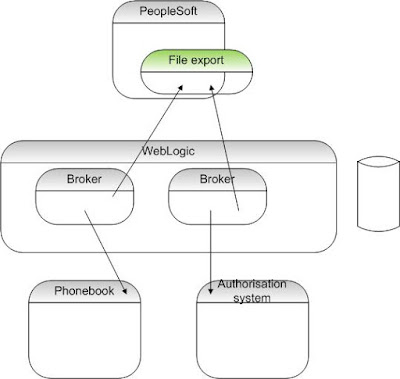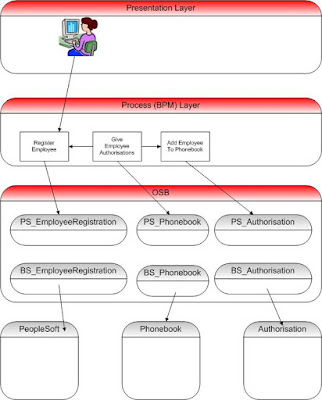In the company I work for, I see a lot of batch oriented, file interfaces. An example is within the proces of where an employee gets employed.
This new employee ie entered within the PeopleSoft system and once a day an export is ran of all employees. This file contains the action that has to be taken towards other systems (add, delete, update). The other systems are phonebook system and authorisation system in which the new employee must be registered too. There is even a separate database that keeps track of the files already processed!

This is not what you want, but how would you integrate the systems? Should you use an ESB? Should you use a Common Data Model? Should you include BPM? Should you add another presentation layer?

All this creates a lot of overhead for a secondary process, just to SOAlize/BPM it. So what are the benefits to use this elegant IT solution?
I think:
* Monitoring of the process, so better maintenance
* Easier to change the process (for example other authorisation levels for different employees)
* Easier to change an implementation for a system
* Realtime update of the employee information instead of waiting a day or more
What's your experience in these kind of situations?
This new employee ie entered within the PeopleSoft system and once a day an export is ran of all employees. This file contains the action that has to be taken towards other systems (add, delete, update). The other systems are phonebook system and authorisation system in which the new employee must be registered too. There is even a separate database that keeps track of the files already processed!

This is not what you want, but how would you integrate the systems? Should you use an ESB? Should you use a Common Data Model? Should you include BPM? Should you add another presentation layer?

All this creates a lot of overhead for a secondary process, just to SOAlize/BPM it. So what are the benefits to use this elegant IT solution?
I think:
* Monitoring of the process, so better maintenance
* Easier to change the process (for example other authorisation levels for different employees)
* Easier to change an implementation for a system
* Realtime update of the employee information instead of waiting a day or more
What's your experience in these kind of situations?
Reacties
Een reactie posten